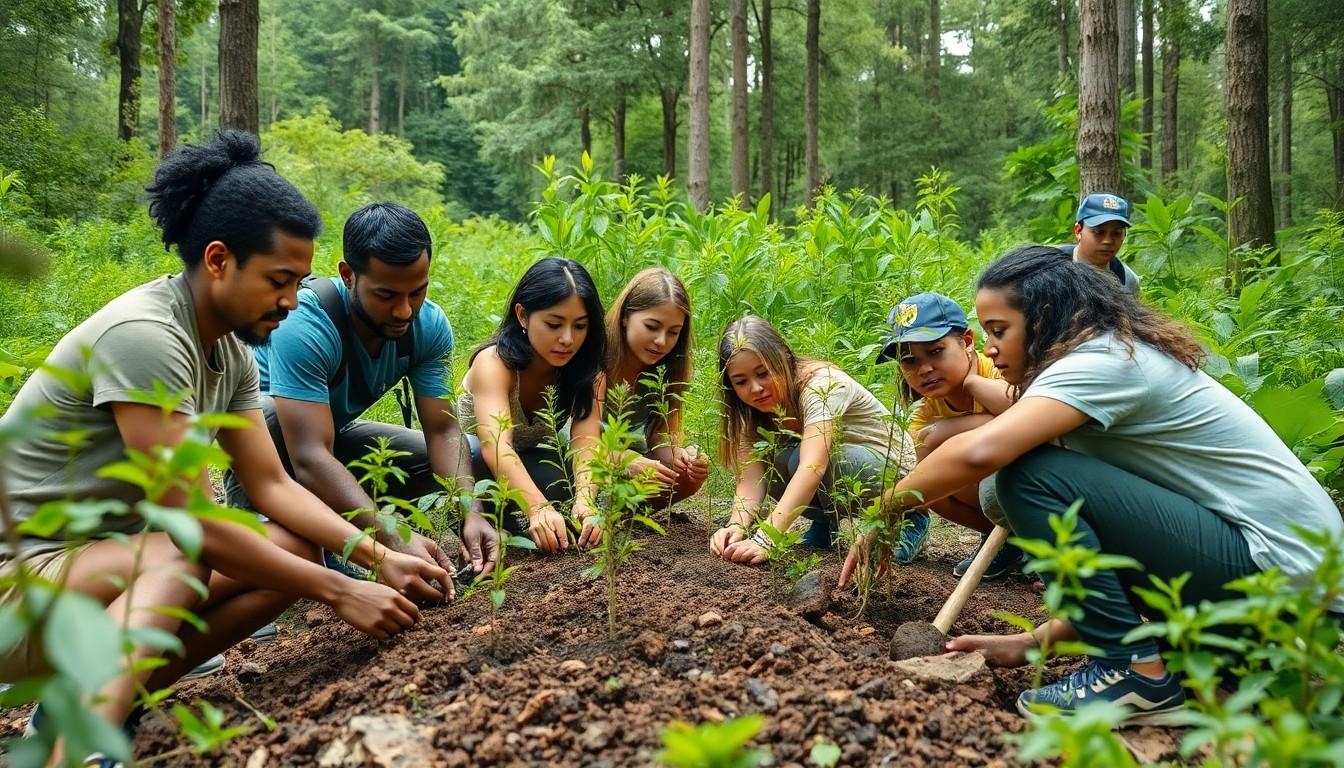Nature’s got a serious case of the Mondays, and it’s up to everyone to help turn that frown upside down. With habitats disappearing faster than socks in a dryer and species playing hide-and-seek with extinction, the call for conservation has never been more urgent. It’s not just about saving the cuddly koalas and majestic elephants; it’s about preserving the intricate web of life that keeps the planet spinning.
Conservation Of Nature
Conservation plays a crucial role in maintaining the health of our planet. Protecting natural habitats ensures the survival of numerous species and promotes a balanced ecosystem.
Biodiversity Preservation
Biodiversity encompasses the variety of life within ecosystems. Maintaining this diversity supports resilience against environmental changes. Protecting lesser-known species alongside charismatic megafauna fosters overall ecosystem stability. Preserving biodiversity also contributes to genetic variation critical for adaptation and survival. According to the World Wildlife Fund, over 1 million species are currently at risk of extinction due to habitat loss and climate change. Efforts that focus on preserving entire ecosystems more effectively safeguard the intricate relationships among species.
Ecosystem Services
Ecosystems provide vital services that support human life. Pollination, water purification, and climate regulation are among these critical functions. Healthy ecosystems produce food, mitigate natural disasters, and support clean air and water sources. The United Nations estimates that ecosystems underpin approximately 50% of global GDP, emphasizing their economic importance. Conservation efforts aimed at preserving these ecosystems ensure sustainable resource availability for future generations. Supporting these initiatives protects both nature and human welfare.
Threats To Conservation Of Nature
Numerous factors threaten conservation of nature. Understanding these threats helps in developing effective responses.
Climate Change
Climate change significantly impacts ecosystems. Rising temperatures alter habitats crucial for various species. Coral reefs, for example, face bleaching due to warmer ocean waters. Unpredictable weather patterns lead to extreme events like floods and droughts, challenging many species’ survival. Additionally, altered migration patterns disrupt breeding cycles for birds and other animals. Immediate action against climate change remains vital to protect biodiversity and ecosystem stability.
Deforestation
Deforestation poses a substantial risk to conservation efforts. Forests, which cover approximately 31% of Earth’s land area, support essential habitats for many species. Logging, agriculture, and urbanization contribute to habitat loss and fragmentation. This results in decreased biodiversity as species struggle to adapt to new environments. Moreover, deforestation exacerbates climate change by releasing stored carbon dioxide into the atmosphere. Addressing deforestation is crucial for maintaining ecosystem health and mitigating global warming effects.
Pollution
Pollution encompasses various contaminants that threaten wildlife and ecosystems. Water pollution, caused by agricultural runoff and industrial waste, degrades aquatic habitats. Terrestrial habitats suffer from soil and air pollution, impacting plant and animal health. Plastics and other inorganic materials disrupt food chains, harming species from insects to large mammals. Additionally, chemical pollutants can cause reproductive issues in many wildlife populations. Combating pollution remains essential for the health of both ecosystems and human communities.
Strategies For Effective Conservation
Effective conservation requires diverse strategies to address pressing environmental challenges. Focus on specific approaches can enhance biodiversity and ecosystem resilience.
Protected Areas
Protected areas serve as vital sanctuaries for numerous species. They provide secure habitats that limit human activity, allowing ecosystems to recover and thrive. Coverage of about 15% of terrestrial and 7% of marine areas supports the habitats of countless organisms. Special designations, like national parks and wildlife reserves, safeguard these regions. Legislation plays a crucial role in protecting these spaces and ensuring responsible management practices.
Sustainable Practices
Adopting sustainable practices is essential for long-term conservation. Responsible agricultural methods reduce environmental impact while preserving natural resources. Strategies like organic farming and agroforestry promote soil health and biodiversity. Implementing resource-efficient technologies improves energy usage and decreases emissions. Companies can adopt sustainability standards that prioritize conservation efforts in supply chains. Shifting to renewable energy sources decreases reliance on fossil fuels, mitigating climate change effects.
Community Involvement
Community involvement drives effective conservation efforts. Local populations often possess valuable knowledge about their environments, influencing the success of initiatives. Grassroots organizations foster engagement through education and awareness programs. Volunteers enhance conservation projects by participating in habitat restoration and species monitoring. Collaboration between communities and conservation agencies creates a sense of ownership, promoting sustainable practices that benefit both people and nature.
Case Studies In Conservation
Several successful conservation initiatives illustrate the potential for effective strategies.
Success Stories
Successful conservation efforts around the globe demonstrate the impact of focused action. The reintroduction of the gray wolf in Yellowstone National Park restored ecological balance by controlling deer populations. In Kenya, the Amboseli Trust for Elephants established programs that mitigate human-wildlife conflict, leading to increased elephant populations and improved community livelihoods. Overall, these cases highlight how tailored conservation measures can benefit both wildlife and human communities.
Lessons Learned
Valuable insights emerge from various conservation projects. Emphasizing community participation fosters stronger buy-in and enhances sustainability. Research shows that engaging local populations boosts success rates, as seen in Madagascar’s reforestation efforts, where material incentives align with habitat protection. Tracking progress and adapting strategies allows for effective responses to changing environmental conditions. Therefore, flexibility and collaboration remain crucial factors in driving successful conservation outcomes.
Successful conservation initiatives
The conservation of nature is a pressing responsibility that requires immediate action. By prioritizing the preservation of entire ecosystems and fostering biodiversity, society can ensure the health of the planet and its inhabitants. Collaborative efforts involving communities, governments, and organizations are essential for implementing effective strategies that address environmental threats.
Successful conservation initiatives serve as powerful examples of what can be achieved through commitment and innovative practices. As challenges continue to evolve, adaptability and ongoing engagement will be crucial for sustaining these efforts. Protecting nature isn’t just about safeguarding wildlife; it’s about securing a livable future for generations to come.


